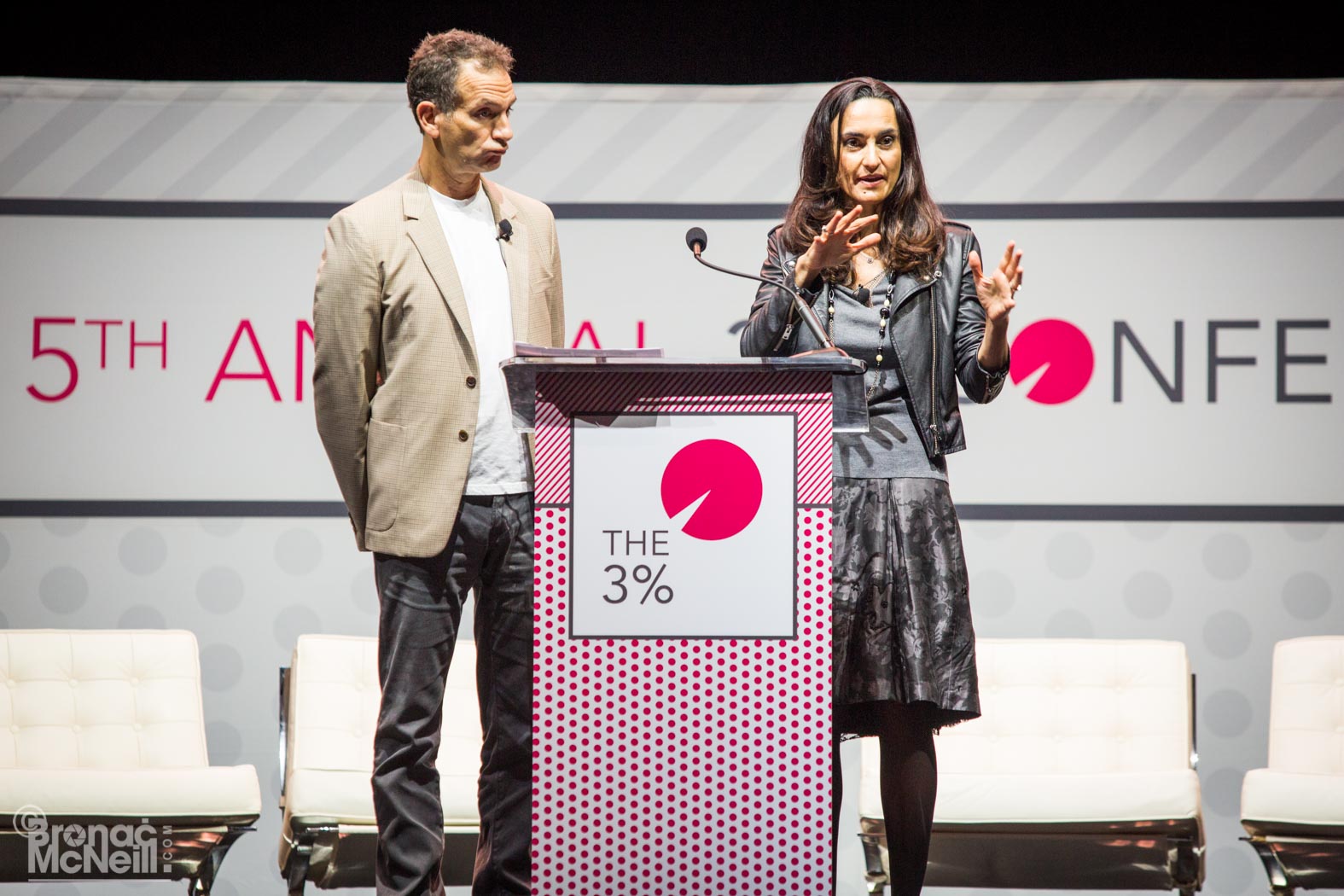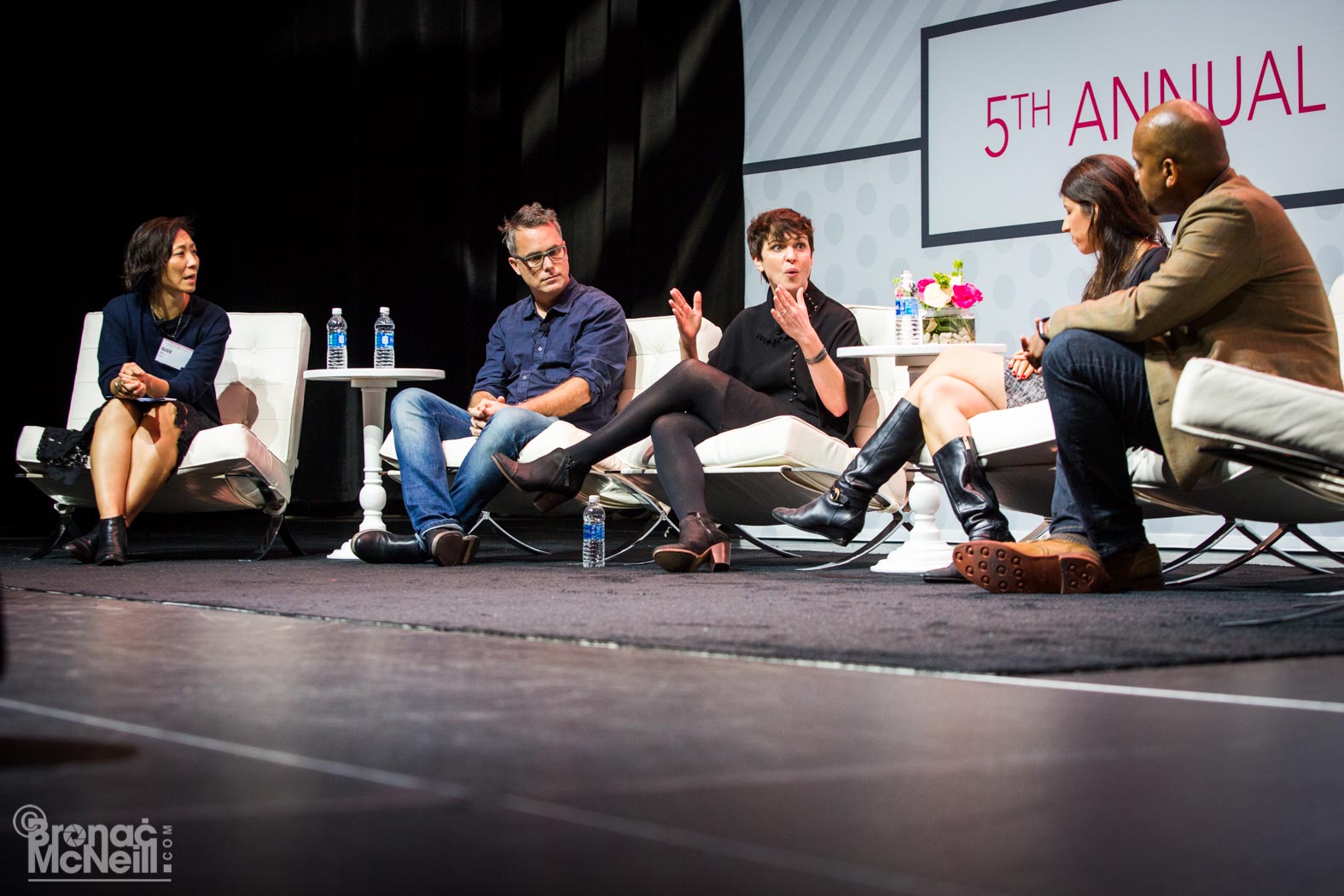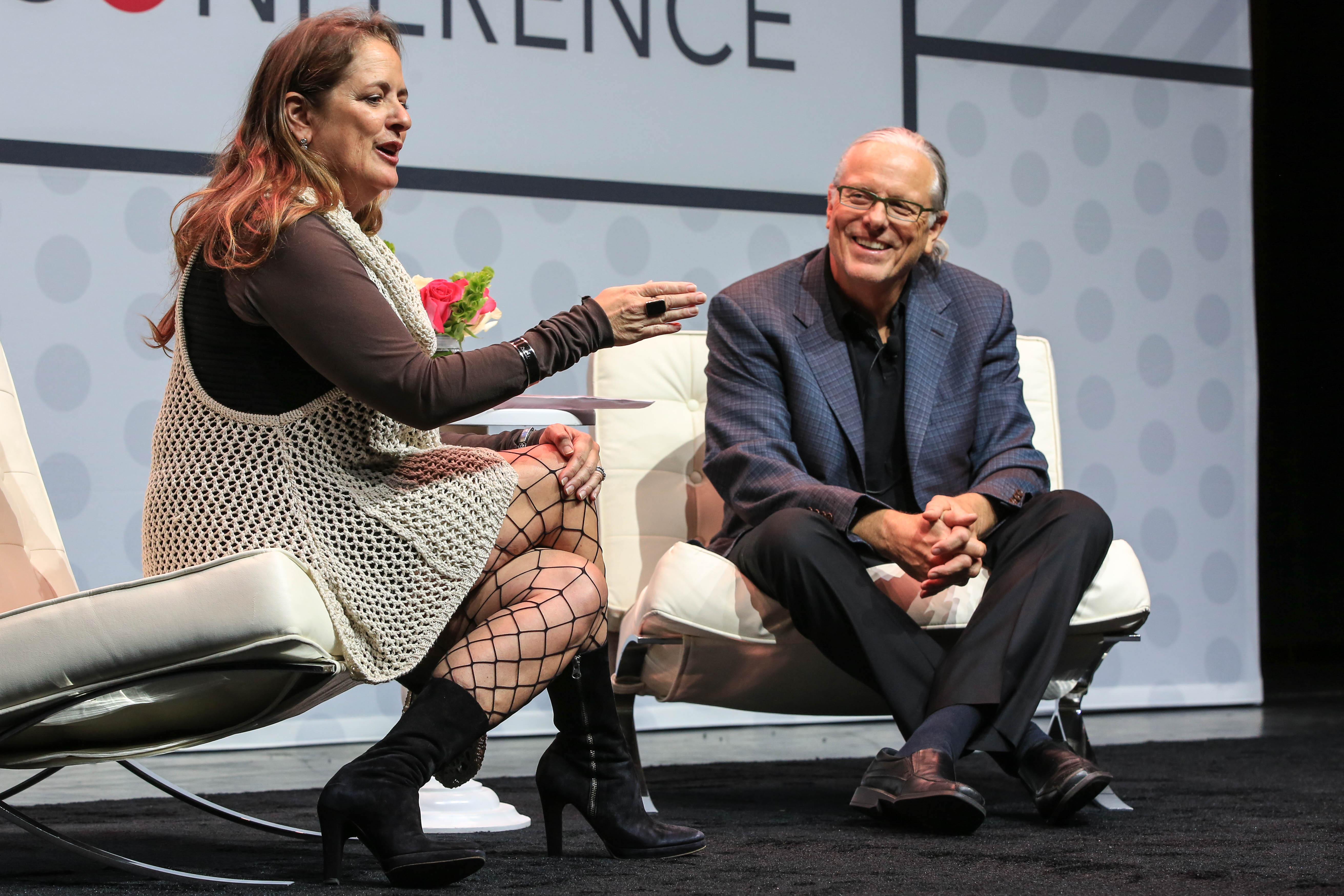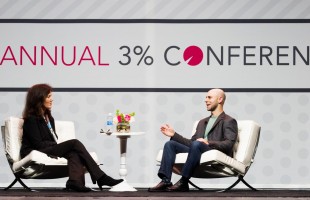
Creative Director Track
Deanna Paquette is a designer/art director at Audible, specializing in brand and editorial design. When she’s out of the office, Deanna keeps busy by trying out new recipes, falling out of headstands, and running Notes on Women—a community dedicated to learning and observing gender and equality. She's also pretty on brand as an Aries.
The advertising industry has for decades attracted the clever, the competitive, and the creative. It has also been referred to as “a boys club” crowded with ad men placing their perspective on labels and selling it to the world. For five years, The 3% Conference has been extending the table to make sure that more diverse ideas have a seat, in hopes that more voices are represented on tv screens, billboards, print ads, and digital surfaces across the world. The Creative Director Track, sponsored by Adobe, covered the power and potential that is in the hands of our advertising leaders to shape the industry’s future, while also reflecting and taking responsibility for the past.
Session 1—Keynote: How to Do Terrible Work
David Lubars, BBDO Chairman, and Berta De Pablos-Barbier, Vice President, Marketing Mars Chocolate North America taught us the impact that a healthy client/agency relationship can bring by highlighting what not to do. Whether you are client side or agency side, Lubars and De Pablos-Barbier shared key insights they’ve learned through years of challenging each other.

Don’t make assumptions
So they haven’t done it before—maybe they’ve never been asked. These short spots for Twix were created in response to the social phenomenon, Throwback Thursday. With a smaller budget and new channel, Mars gave BBDO an opportunity to create work outside of their familiar territory. They rose to the challenge and the results speak for themselves:
- TWIX Bites - "Walkman" https://www.youtube.com/watch?v=1vWxQ_b11GQ
- TWIX Bites - "Hairspray" https://www.youtube.com/watch?v=qgK_sPmlT18
- TWIX Bites - "Flat top" https://youtu.be/MzxVqaUS5s4
Don’t confuse a strategy for an insight
Spend less time on the strategy and more on what the feeling/idea is you want to convey. It’s the insight that leads to the holy grail, as illustrated in the Snickers "You Can't Spell When You're Hungry" campaign.
Don’t mistake insights for a concept
A two-dimensional portrayal of your audience is a dangerous outcome of literally interpreting test results. In Dove’s “Each and Every Day” spot, they went deeper asking, “Who is the woman we want to portray to our audience?” Not a mom, not a wife, not a professional woman, not flirting, she is just who she is—not defined by a role.
Session 2—Panel: Branding Beyond the Brief
With evolving technology disrupting the workplace, what changes can we expect to see in the ad industry? Nick Childs, CCO of Initiative, discussed how some agencies are already adapting their process to create innovative work for brands with three industry leaders. Tiffany Hardin, Founder of Gild Creative Group & She Knows Now; Nick Barham, Global Chief Strategy Officer of TBWA\Worldwide; and Resh Sidhu, Creative Director at Framestore's VR Studio, shared their perspectives and experience navigating new tools and practices that define future-thinking brands.
Adapt differently
Nick Barham compared the agency environment to a network, noting that the perception of big agencies is that they are bloated and certainly not agile in contrast to a social network that is active and where communication is responsive. “Let’s see social networks as inspiration rather than just a channel,” Barham suggested. At TBWA\Worldwide they’re stepping away from PowerPoints and using platforms like Instagram to communicate insights and provoke creative thought. “We have decks and data, but we need more conversations about how it brings people together"
Welcome new perspectives
If new tech can inspire process, then there is a lot to learn from the evolution of virtual reality. Resh Sidhu of Framestore VR notes that every day ”there is new homework to be done,” and that “throwing out traditional learnings” is a constant. Sidhu credits the new industry’s adaptability to the overwhelming amount of female talent. “Hungry women are excited to be in a place where decades of rules being written predominantly by white men don’t exist.” For Tiffany Hardin, it is imperative to bring authentic representation. She stated, “If I’m the person who has to sit at the table and be the person who points out inauthenticity, I will do that.”
Reframe the conversation with clients
The challenge is in uniting as teams and as an industry, ushering clients to create meaningful, impactful work truly grounded in culture. It means reframing concerns like, “What does it cost? How is measured?” to accurately reflect the impact of authentic, cultural work. So we move toward concerns like, “How much does that moment cost? How can we measure that feeling?” Still—do we have an answer for that? According to Sidhu, we can let the consumers decide.
Session 3—Lunch + Learn Panel: Reimagining the Creative Workplace
Anyone who has attended a 3% Conference can verify—there is not a lack of diverse talent in this industry. So why are we still having unequal representation in our workplaces? Susie Nam, Chief Operating Officer Droga5 looked for insight from Vann Graves, CEO & CCO, FL+G; Jay Russell, CCO, GSD&M; Jessica Peltz-Zatulove, Partner, KBS Ventures; and Jaime Robinson, Co-Founder/Chief Creative Officer, Joan.

Know what really drives retention
It’s not primarily job title and salary that retains employees (as too many companies mistake,) but progress and shared values. Staffing plans are a broken model, so Jay Russell set out to create his own interpretation of the Periodic table for building a team. The product is a system that takes into consideration people’s strengths and passions and gives them each a position to form better creative solutions. This approach combats the unconscious bias of hiring people that think (and look) like you.
Creating diversity is work
“You can’t just rely on HR or recruiters to hand you portfolios.” Jessica Peltz-Zatulove suggested. Diversity comes from the curation of the Creative Director to choose teammates. We have to do more. We have to make a plan and hold ourselves and our counterparts accountable.
Manage expectations
Peltz-Zatulove continued to ask that we manage employee expectations. She said, “It holds people back when you coddle them.” The conversation should address how long they can expect between titles, let them know the skills needed for the next level, and point them to where they can find help growing.
Commit to creating a space for all people
Diversity goes beyond “I hired a woman: check!” Vann Graves advised that you need to commit to making a safe space for creativity. It is key for the creative director to act as the armor, so individuals can feel included and safe to be themselves.
Jaime Robinson demanded,
Leaders must also lead by example and show “I’m open to criticism, too.”
When you create that culture of acceptance, you minimize imposter syndrome and the feeling of unworthiness.
Session 4—Legends
In the next session, two creative ad legends discussed their career beginnings, paid homage to those who’ve influenced them, and reflected on the simple things that turn great into legendary. Susan Credle, Global Chief Creative Officer of FCB Global, is creatively known for humanizing M&M’s and for the legendary Allstate’s “Mayhem” campaign. Jeff Goodby, Co-Chairman and Partner, Goodby Silverstein & Partners, is also the guy who originally wrote “got milk?” on a napkin.

Simple recognition goes a long way
Susan Credle began in the ad industry when BBDO was the boys club of Madison Avenue and she was (surprise!) a secretarial intern. After the Creatives left for the day, Susan would stay late, typing up their work. Also putting in late hours, the CCO noticed Credle. He offered her a safe ride home, during which they talked about advertising. It surprised her that he took interest, recognized her and knew her name. “In leadership it is easy to forget how important recognition is and how simple it is to say ‘hi’ and check-in,” she noted. The power of inclusivity followed her for the rest of her career.
Treat people as individuals and incentivize accordingly
According to Jeff Goodby, we should figure out what makes people feel good and work hard, and be more sensitive to what motivates an individual to be their best. We like to think we are so different, but men also feel unrecognized and invisible, he cautioned.
Goodby also didn’t shy away from calling out that the ad world was a “classic men’s club.” He recalled a time when there was maybe one woman in the entire creative department.
Today, the biggest factor of women being happy in the workplace is leadership.
As leaders, we must look to the common practices that were established when individuals were rewarded for being a man’s man.
Session 5—If Only Advertising Could Use Its Powers for Good
The ads we create have the power to make lasting impressions across the globe. In knowing the reach and impact our ideas have, should we be more responsible with the messages we send? During this panel we saw three stellar examples of authentic advocation that challenged lazy, industry stereotypes and showed real results.
Josy Paul, Chairman + CCO, BBDO India, spoke of the stunning success of “Share the Load,” a message executed with P&G India for Ariel, a laundry detergent brand. We watched a spot that encouraged gender equality in India’s homes, instead of defaulting to the usual cliches: grass stains, red wine spills, and before and afters. “It was meant as local campaign, but the empathy element carried it internationally. ‘Share the Load’ isn’t a baseline or a campaign, it is an invitation,“ said Paul on the success of the movement.
“The feedback and emotional responses sustain you, you wonder why you haven't done this before.“
Amy Law, Creative Director Swirl, Inc., demanded to see more kinds of women represented in media. She partnered with the ANA's Alliance for Family Entertainment (ANA AFE) and Girls' Lounge to launch #SeeHer, whose focus is to expand representation in media so that all women and girls get to see themselves reflected.
Vida Cornelious of Walton Issacson shared Inside Out, a web series from Lexus that demonstrated what reaching the LGBTQ community looks like, without pandering. “It is a business opportunity when you connect to an audience. Those connections translate to sales. When you deeply impact a people, the relationship needs to be handled with care, the continued conversation needs to be authentic,” she said.
Recapping the Track
During the Creative Director Track, leaders from across the industry shared their modi operandi—going beyond superficial solutions and exposing the elements that create true equality. As Jaime Robinson stated, “We need comfortable, confident, and secure leaders” in order to create workplaces that are as inclusive, as they are creatively fulfilling.
We need engagement from creative directors like never before when it comes to redefining workplace norms, breaking recruiting habits, and setting an example of what openness looks like.
Equality also starts with collaboration. With external partners, it comes by building trusting relationships rooted in the same shared ambitions and driven by authentic insights. With team members, it’s about creating open dialogue and managing expectations. Committing to these changes not only impacts and empowers women, but it also paves the way for an inclusive creative industry that represents the voices of all humans.
To borrow a brilliant phrase from Amy Law, “I’m a recovering misogynist.” Yet, for the past couple of years I’ve been identifying expressions of inequality–not only the blatant displays, but also the condoned behaviors inherited by all us. It’s no longer enough to point out that the playing field is unfair. It’s time to hold up a mirror to ourselves, our colleagues, our mentors and mentees, our organizations, our friends and family. It’s time to address the misconceptions that have lead to normalizing behaviors that in turn, oppress other people.
It’s not just the conversation, but also the responsibility and honesty the leaders brought to the stage that have left me feeling hopeful and supported to grow into leadership roles. Here’s to owning our actions, being open to others, and standing up for the right work, the good work, for human work.




